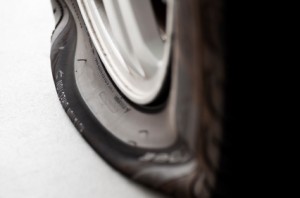Tire wear is inevitable, as is the gradual reduction of the rubber treads that happen as you drive, in addition to oxidation of the rubber and stress on the belts. Unnecessary tire wear, however, is excessively fast wear – the result of failing to maintain your tires, reducing their lifespan and requiring you to purchase new ones much sooner.
Because tires are expensive, often exceeding $100 per tire, it is cheaper to maintain your tires and is better for the environment as well. By performing these three simple tire maintenance activities on a regular basis you can maximize your tires’ life span and ensure that you get the most value from your investment.
Maintain Proper Tire Pressure
Every tire is rated for a specific amount of air pressure, which is the amount of air inside the tire. When the air pressure gets low, the tire loses its firmness and becomes slightly flat. This results in parts of the tire pressing against the ground that aren’t supposed to which increases the wear on the treads, belts and other parts of the tire and reduces the overall lifespan of the tire.

To keep its pressure where it should be, check the tire’s pressure before driving since warm tires will have a higher pressure than cold tires. Use a pressure gauge to determine if your tire needs more air. If it does, inflate the tire with an air pump, then recheck the pressure. You can determine your tire’s pressure rating by reading the sticker on the inside of your car’s door, or if a sticker isn’t present by consulting with a dealer or a manual for your car’s make and model.
Instead of filling the tires with air, you can inflate then with nitrogen at a nitrogen pump station. Nitrogen increases your tires’ lifespan because it is dry and doesn’t cause oxidation, which breaks down the inside of the tires.
Get An Alignment
On any vehicle, the wheels are supposed to be aligned so that the tires are parallel to each other and perpendicular to the ground. This causes the centermost part of the tire to ride on the asphalt and ensures that all the tires wear evenly.
If you hit a large pothole, take a speed bump too fast, replace one of the shocks or have a wheel replaced you’ll need to get an alignment at a service station or auto mechanic. If you drive a car that is out of alignment the tires will wear unevenly and in areas where they shouldn’t, resulting in bald areas or worn tread edges greatly reducing the lifespan of the tires.
Rotate Your Tires Regularly
Rotating tires means that the tires on your car are swapped positions so that they wear more evenly, which increases their lifespan by decreasing the odds of developing a bald spot or other problems. Tires are typically rotated every 3,000 miles when the car is taken in for an oil change and many service stations will balance the tires after rotating, which reduces vibration while the car is driven. Maintaining your tires isn’t always convenient, but it will save you much hassle and money in the future if done regularly.
